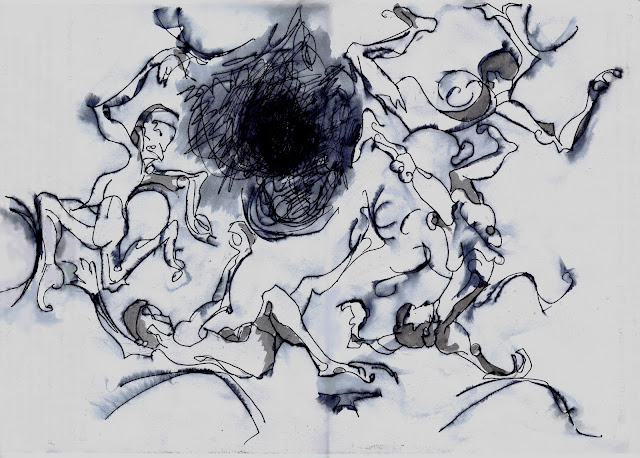20-01-2020.
It is a collage, but
a digital one, most of his illustrations I cropped a bit then mixed it all up.It's got me thinking now - if I've got time I'll write it out. Its reminding
me of a large hanging from Rajasthan
I love his border colours and the way he carefully laid it all out, put
together with a lot of love.
Charles
Dellschau
Homage to a Butcher.

It started off as a study of a note book by Charles
Dellschau, concerning aeroplanes & the design thereof.
The first thing that grabbed me was the bright colourful, yet earthy borders
quite a comparison to the flying machines.
I thought that the best way to study them would be to work with them.
At present, I am thinking of ways to represent a fictional games board &
thinking along those lines I felt that his borders would fit in and even solve
a linear problem.
 |
| simplicity in a nut shell! |
Eventually, I ended up with a Ludo board which would have various rectangles
into which; I could insert some of his illustrations. & combined that with
an old fashioned Cluedo board.
 |
| I suppose this one had the flavour that I was ultimately after! |
Two images that I cropped to fit into the frame more comfortably.
I started to work it as a kind of collage, only digitally. A
kind of cut & paste affair in a stencil type fashion in that I was putting
the boundaries onto the images rather than the other way round.
 |
| a PNG file meant that the white areas are in fact transparent. |
 |
| putting the boundaries onto images. |

 |
future frame?

 |
| Charles Dellschau |
Charles
Dellschau
His story is one shrouded in mystery, almost lost forever, intertwined
with secret societies, hidden codes, otherworldly theories and seemingly
impossible inventions before his time. Unseen for decades and salvaged by a
junk dealer in the 1960s from a trash heap outside a house in Texas, his entire
body of work would later go on to marvel the intellectual world. But during his
lifetime, Charles Dellschau had only been known as the grouchy local butcher.
a
remarkable collection of strange watercolours and collage pieces. More than
2,500 intricate drawings of flying machines alongside cryptic newspaper
clippings filled the pages, crudely sewn together with shoelaces and thread.
After
his retirement in 1899, he took to filling his days by filling notebooks
with a visual journal of his youth. He called the first three books, Recollections and
recounts a secret society of flight enthusiasts which met in California in
the mid-19th century called the ‘Sonora Aero Club’.
The
Wright Brothers wouldn’t even make their famous first flight until
1903, but Dellschau draws dapperly-dressed men piloting brightly-coloured
airships and helicopters with revolving generators and retractable landing
gear. No records have ever been found of the Sonora Aero Club but Dellschau’s
artworks hide a secret coded story. Whatever it was that he had to say was
apparently too private even for his own notebooks and even today, much of the
mystery has yet to be revealed.
A Mr.
Pete Navarro, graphic artist and UFO researcher, heard about the “Flight”
exhibition in 1969 and became enthralled. He believed there was a connection
between Dellschau’s drawings and mysterious mass of “airship” sightings at
the turn of the century across 18 states from California to Indiana. In 1972,
he discovered that 8 remaining books of Dellschau were still sitting at the
junk shop, unwanted and unclaimed. He bought the lot for $565 and spent the
next 15 years obsessively decoding Dellschau’s work.
Some of
his drawings tell of fatal crashes of the society’s airships, sabotage of other
club members and the banning of members who talked about the secret
organisation to outsiders. According to Dellschau, the club’s aero prototypes
would travel the open roads disguised as gypsy wagons to avoid detection.
|










































